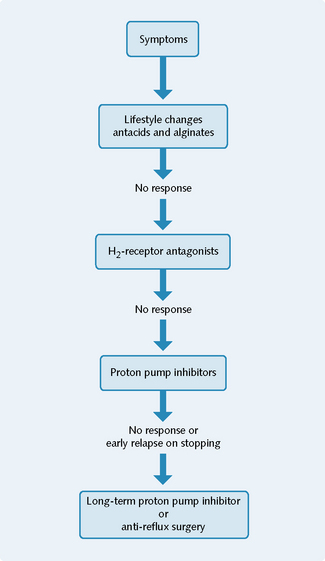8 Gastrointestinal system
The stomach
Peptic ulceration
Protective factors
The mucosal defences against acid/enzyme attack consist of:
Acid secretion
The regulation of acid secretion by parietal cells is especially important in peptic ulceration and constitutes a major target for drug action (Fig. 8.1). Acid is secreted from gastric parietal cells by a unique proton pump that catalyses the exchange of intracellular H+ for extracellular K+. The secretion of HCl is controlled by the activation of three main receptors on the basolateral membrane of the parietal cell. These are:
Gastro-oesophageal reflux
Stomach contents are normally prevented from re-entering the oesophagus by the lower oesophageal sphincter (LOS). Loss of tone of the LOS, or a rise in intra-abdominal pressure are the commonest causes of GORD, of which heartburn is the major symptom. Conservative treatment options include weight loss and raising the head of the patient’s bed. Precipitating factors should be avoided, as should excess smoking and alcohol. The drugs used in GORD are the same as for other acid-related disorders (Fig. 8.2).
Prevention and treatment of acid-related disease
Reduction of acid secretion
Proton pump inhibitors (PPI)
Omeprazole and lansoprazole are examples of PPIs.
Mechanism of action
PPIs cause irreversible inhibition of H+/K+ ATPase that is responsible for H+ secretion from parietal cells (see Fig. 8.1). They are inactive prodrugs and are converted at acidic pH to sulphonamide, which combines covalently and thus irreversibly with -SH groups on H+/K+ ATPase. This inhibition is highly specific and localized.
Histamine H2-receptor antagonists
Examples of H2-receptor antagonists include cimetidine and ranitidine.
Mucosal strengtheners
Misoprostol
Mechanism of action
Misoprostol is a synthetic analogue of prostaglandin E. It imitates the action of endogenous prostaglandins (PGE2 and PGI2) in maintaining the integrity of the gastroduodenal mucosal barrier, and promotes healing (Fig. 8.1).
Indications
Ulcer healing and ulcer prophylaxis with non-steroidal anti-inflammatory drug (NSAID) use.
Therapeutic notes
Misoprostol is most effective at correcting the deficit caused by NSAIDs that inhibit cyclooxygenase-1 and reduce prostaglandin synthesis (Ch. 10). Misoprostol can prevent NSAID-associated ulcers, and therefore is particularly useful in elderly people in whom NSAIDs cannot be withdrawn.
Antacids
Examples of antacids include aluminium hydroxide and magnesium carbonate.
Mechanism of action
Antacids consist of alkaline Al3+ and Mg2+ salts that are used to raise the luminal pH of the stomach. They neutralize acid and, as a result, may reduce the damaging effects of pepsin, which is pH dependent (Fig. 8.1). Additionally, Al3+ and Mg2+ salts bind and inactivate pepsin.
Contraindications
Aluminium hydroxide and magnesium hydroxide should not be given to people with hypophosphataemia.
Nausea and vomiting
Basic concepts
The commoner causes for nausea and vomiting are shown in Figure 8.3. The act of vomiting is coordinated in the vomiting centre within the brainstem. This centre receives neuronal input from several sources, though fibres from the chemoreceptor trigger zone (CTZ) of the fourth ventricle appear fundamental in bringing about emesis. The CTZ lies outside the blood–brain barrier, and is sensitive to many stimuli, such as drugs and endogenous and potentially exogenous chemical mediators. The CTZ contains numerous dopamine receptors, which partially explains why anti-Parkinsonian drugs (dopaminergic drugs) often induce nausea and vomiting, whereas some antidopaminergic drugs are used as antiemetics.
Stay updated, free articles. Join our Telegram channel

Full access? Get Clinical Tree





